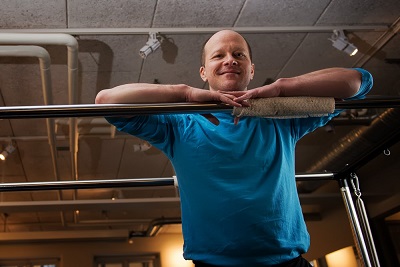So today I would like to take up breathing, a subject as we all know that is central the Pilates technique. Joseph Pilates himself wrote extensively about posterior lateral breathing, taking the air into the lower back part of the lungs, with the idea to widen the chest area in the process. Now that is an article in itself that we can save for a later date. The aspect of breathing that I want to bring up is…..what if the client is not breathing almost at all? I think we all have experience with this client, through the better part of exercises given, especially those that involve movement and usage of the upper torso, his breath is held and periodically a rather forceful exhale comes forth followed by a gasp inward, and then again the breathing stops.
Now, a popular way to deal with this is to instruct the client to remember to breathe. That is, to overcome the tension in the breathing parts by overriding it. But I wonder if this is really that helpful. Does a person really need to remember to breathe? When you look closely, what is happening is that while performing the exercise, the tension in the clients body, particularly in the neck, shoulder and chest area, is prohibiting that free function of the parts used in breathing. So, while a reminder to breathe may, for a time, get the client to use the parts for breathing in a more forceful manner to overcome the tension that is there, it is possible that this correction simply adds more tension, which is the cause of the problem in the first place.
I propose a more indirect route. First of all, more times than not, the client is wholly unaware that he is not breathing. And the first step in assisting the client is to show him this in a helpful and supportive manner. The large gasp outward after a period of holding the breath is the telltale sign that this happening, and when the clients attention is brought to this, and is is explained to him why it is happening, then he himself can see ‘the problem’ first hand with every gasp afterward. And that is a great thing……and what I then do is to not correct really further the problem for a while, but just allow the condition to continue and allowing the client to become more conscious of the condition. This is a little work in itself, for when the client is shown that he is doing ‘something wrong’, he will more times than not attempt to fix the problem directly. So I encourage the client to continue ‘being wrong’, while at the same time noticing that the breath-holding and gasping pattern is present, and resist the urge to fix the problem. As the session continues, I begin to point out the excess tension, especially in the neck, shoulder and chest area, while continuing to encourage the client to resist the urge to ‘fix’ the problem.
After a bit, I think we are ready for the next step….and that is to begin to do more simple exercises, and this time helping the client to release the neck, shoulder and chest area, and bring the strength down into the center of the body. This is not always easy….since the amount of tension that is in the body is what actually feels right to the client. But one very effective way that I like to use at times is that I myself will do the simple exercise, asking the client to place his hand on me neck or my shoulders while doing it. I first will then purposefully add tension while carrying out the exercise. And then I will do it a second time with much less tension, and this can often help the client to feel and recognize himself in his own body the similar pattern, and with gentle guidance, and perhaps a gentle touch to the neck and should area now and then, the client can begin to perform simple exercises with less tension….thus allowing the breathing parts to function more as they should, and without force or remembering, the client is breathing more rhythmically and gasping less.

